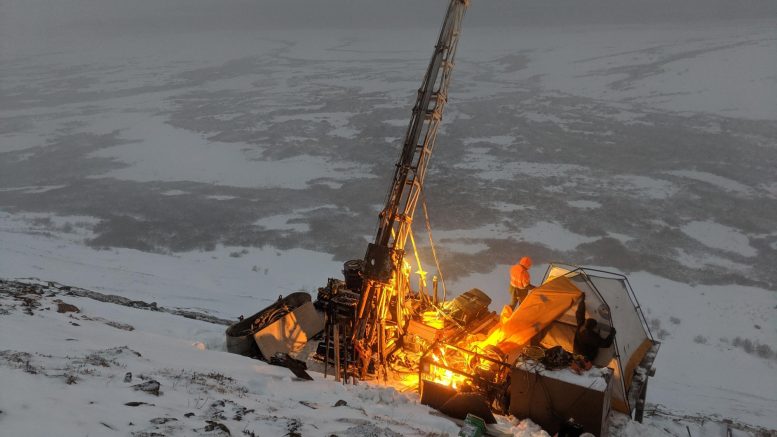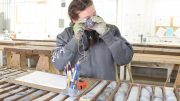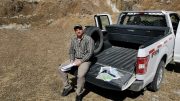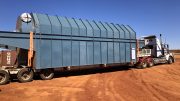In mid-January Graphite One’s (TSX: GPH; US-OTC: GPHOF) Graphite Creek project in Alaska was designated as a High-Priority Infrastructure Project (HPIP) by the U.S. government’s Federal Permitting Improvement Steering Committee (FPISC). The approval comes after the project was originally nominated for HPIP designation by Alaskan governor Mike Dunleavy in October, 2019.
In his 2019 nomination letter to the FPISC, Governor Dunleavy wrote that designating Graphite Creek as a High-Priority Infrastructure Project “will send a strong signal that the U.S. intends to end the days of our 100% import-dependency for this increasingly critical mineral.”
The Vancouver-based company says that Graphite Creek, which is located in Alaska’s Seward Peninsula, about 55 km north of the city of Nome, is the highest grade and largest known large flake graphite deposit in the U.S. The site is adjacent to the Imuruk Basin, which opens into the Bering Strait that separates Alaska from Siberian Russia.
The HPIP designation allows Graphite One to list on the U.S. government’s Federal Permitting Dashboard, which ensures that the various federal permitting agencies coordinate their reviews of projects as a means of streamlining the approval process.
Reflecting on the HPIP designation, Graphite One’s president and CEO, Anthony Huston, told The Northern Miner it highlighted that their project has dual interests for the American economy as it seeks to move forward.
“Our project was found to qualify under both the ‘renewable energy’ and ‘manufacturing’ sectors, which shows the versatility of natural graphite as a tech metal essential to the U.S. economy,” he said. “You’ve seen the surge in attention that renewable energy is getting: electric vehicles (EVs), energy storage systems, lithium-ion (Li-Ion) batteries of all types. So getting the High-Priority designation is a very strong signal of the role our project will play in the U.S.’s 21st Century technology development.”
With the U.S. almost entirely dependent on imported graphite, Huston believes the Graphite Creek project is essential. “We’re seeing strong statements on the importance of the renewable energy transition, and an understanding that materials like the advanced graphite we plan to produce are essential to that renewable transition,” he said.
Huston also highlighted an executive order issued by U.S. President Joe Biden in late January as further proof of Graphite Creek’s viability.
“When President Biden issued his executive order, he referred directly to mining and to materials. And when new Secretary of Energy Jennifer Granholm testified in her nomination hearing in the Senate, she had a very detailed back-and-forth with [Alaskan] Senator Lisa Murkowski, the Senate’s thought-leader on critical minerals issues. Secretary Granholm couldn’t have been any clearer: She said, ‘We can buy electric car batteries from Asia, or we can make them in America.’ Pretty simple, pretty strong. We at Graphite One couldn’t agree more.”

Inside Graphite One’s facility in Nome, Alaska, with (from left) manager Blake Bogart, Sen. Lisa Murkowski, COO Stan Foo and president & CEO Anthony Huston. Credit: Graphite One
According to a 2019 resource update, the project has measured and indicated mineral resources of 10.95 million tonnes grading 7.8% graphite for 850,534 contained tonnes of graphite. The inferred resource stands at 91.89 million tonnes grading 8% graphite for 7.3 million tonnes. The resource estimate used a cut-off grade of 5% graphite.
Pre-production capital costs estimated in the company’s preliminary economic assessment (PEA) from 2017 were estimated to total US$363 million, which included building both a processing plant and a manufacturing plant.
The PEA envisioned an open pit mine life of 40 years with the processing plant producing 60,000 tonnes annually of graphite concentrate once full production is reached. The manufacturing plant is expected to convert the concentrate into 41,850 tonnes per year of coated spherical graphite for use in Li-Ion batteries.
According to the company, graphite showings at the site were first found after the 1898 Cape Nome gold rush and were intermittently extracted beginning around 1907.
“Graphite was mined from the deposit during World Wars I and II, and barged down to the Lower 48 [states] to make steel for the war effort,” said Huston. “So here we are more than 100 years after World War I and graphite is now one of a handful of tech metals transforming a new century.”
To Huston, the story of graphite can be summed up in one word: growth.
“Actually [it’s] hockey stick growth, driven by EV demand, by energy storage system needs as we build out our charging infrastructure,” he said. “The battery industry is due to become the largest sector of demand for the graphite supply chain. The sector is seen aggressively increasing to around 15 times today’s demand by 2030.”
Huston says that Graphite One has also been keenly aware of other mining projects in the state of Alaska that have not reflected well on the industry, and said that environmental, social and corporate governance (ESG) has been an important aspect of advancing their project.
“Community support has been integral for us since day one,’ he said. “We welcome the community’s eyes on us, as we continue to demonstrate, not just in our words but through our actions, how important local support and local participation will be in our project. It’s exciting and we want to make sure the local communities are part of this new venture and all the positive development it can bring.”
As mining operations go, Huston says Graphite Creek will be on the smaller end of the spectrum, more comparable to a quarrying operation, with very little overburden before they reach the graphite, resulting in a lower environmental footprint.
“We are 100% committed to responsible mining, in terms of our environmental impact and the safety of our operations. As CEO, but I would say even more importantly on a personal level, as a parent, I want to see maximum benefits to the local communities, in terms of secure employment, training.”






Do we know the timeline for building (completing) a process and mfg plant? How long does it generally take? As well, does anyone know if an AK or WA site for the plant has been identified? Thanks